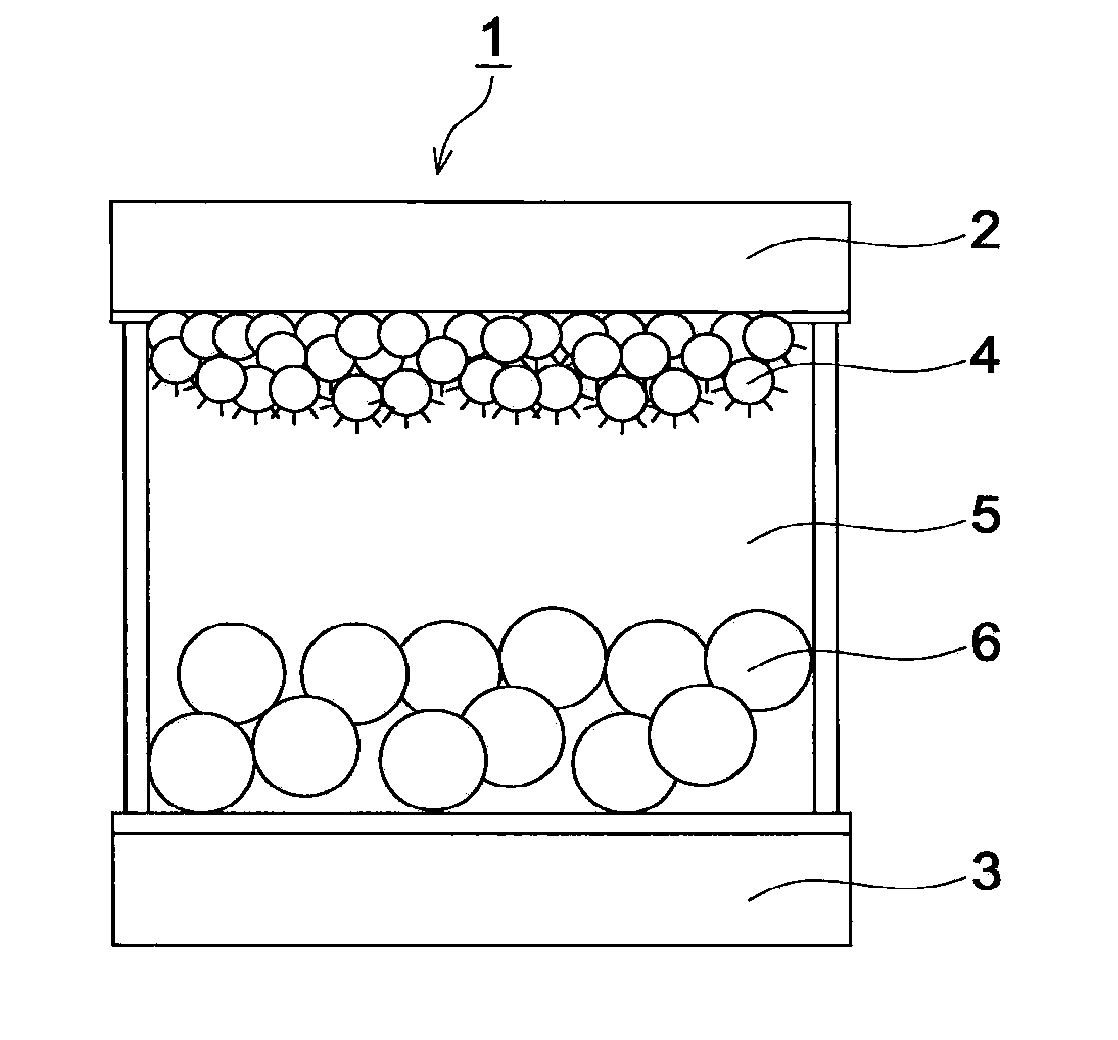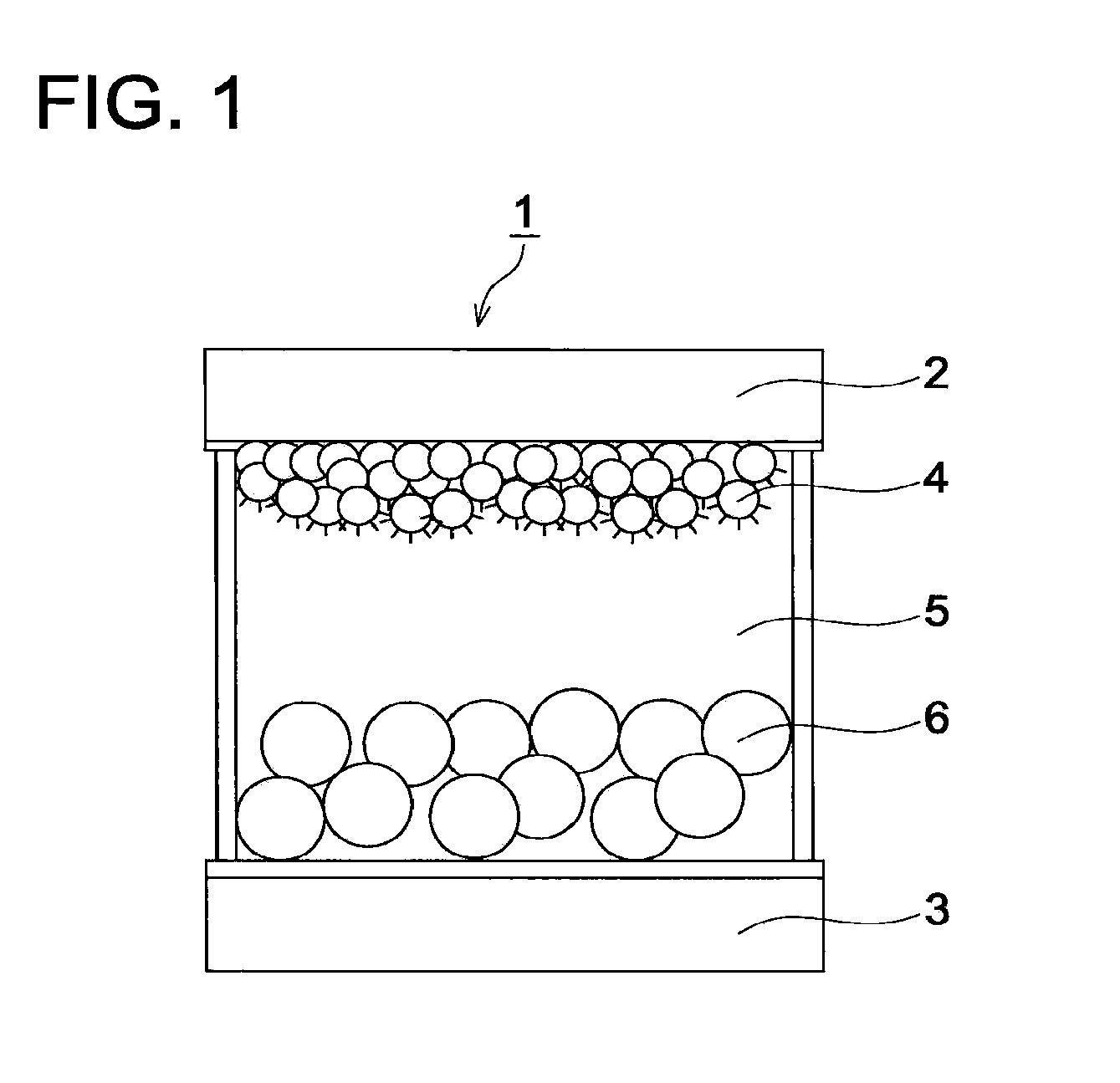Display element
a display element and display technology, applied in non-linear optics, instruments, optics, etc., can solve the problems of certain viewer-friendly, light-emitting display, eye fatigue, etc., and achieve the effect of minimal variation in reflectance and enhanced display contras
- Summary
- Abstract
- Description
- Claims
- Application Information
AI Technical Summary
Benefits of technology
Problems solved by technology
Method used
Image
Examples
example 1
Production of Electrodes
[0194](Production of Electrode 1)
[0195]An ITO (Indium Thin Oxide) film of a pitch of 145 μm and an electrode width of 130 μm was formed on a glass substrate having a thickness of 1.5 mm and a size of 2 cm×4 cm by a well-known method to obtain a display electrode (electrode 1).
[0196](Production of Electrode 2)
[0197]An ITO paste (produced by Sumitomo Metal Mining Co., Ltd.) of an average particle diameter of 20 nm was further blade-coated on electrode 1, followed by firing at 60° C. for 2 minutes and at 450° C. for 30 minutes to obtain a porous ITO electrode (electrode 2).
[0198](Production of Electrode 3)
[0199]A nickel electrode having an electrode thickness of 0.1 μm, a pitch of 145 μm, and an electrode distance of 130 μm was formed on a glass substrate of a thickness of 1.5 mm and a size of 2 cm×4 cm by a well-known method. The thus-obtained electrode was further immersed in a displacement gold plating bath to obtain a gold-nickel electrode (electrode 3) in w...
example 2
[0236]The electrodes, ink liquids, and electrolytic liquids obtained in Example 1 were also used in Example 2 in the same manner.
[0237]>
[0238](Production of Electrode 8)
[0239]A titanium dioxide (4-10 particles of an average particle diameter of 17 nm had been subjected to necking) layer was formed on electrode 1 described in Example 1 and further ink liquid 5 to be described later was applied on the electrode at 120 dpi using an ink-jet apparatus having a piezo head to produce electrode 8.
[0240](Production of Electrodes 9-11)
[0241]Electrodes 9-11 were obtained in the same manner as for electrode 8 except that ink liquid 5 was replaced with following ink liquids 6-8, respectively.
[0242]>
[0243](Preparation of Ink Liquid 5)
[0244]Electrochromic compound EC-1 [bis-(2-phosphonoethyl)-4,4′-bipyridium dibromide] was dissolved in acetonitrile / ethanol at 3 mmol / l to prepare ink liquid 5.
[0245](Preparation of Ink Liquid 6)
[0246]Exemplified compound (1)-26 was dissolved in acetonitrile / ethanol ...
example 3
[0278]The electrodes, inks, and electrolytic liquids obtained in Examples 1 and 2 were also used in Example 3 in the same manner.
[0279]>
[0280](Production of Display Element 3-1)
[0281]A mixed liquid, prepared by adding 20% by mass of titanium dioxide CR-90 (produced by Ishihara Sangyo Kaisha, Ltd.) in an isopropanol solution containing polyvinyl alcohol (average polymerization degree: 3500 and saponification degree: 87%) at 2% by mass, followed by being dispersed using an ultrasonic homogenizer, was coated on electrode 3 whose peripheral portion was edged with an olefin sealant containing a glass-made spherical bead spacer of an average particle diameter of 40 μm at a volume fraction of 10% to allow film thickness after drying to be 20 μm. Thereafter, drying was carried out at 15° C. for 30 minutes to evaporate the solvent and then further drying was carried out under an ambience of 45° C. for 1 hour.
[0282]A glass-made spherical bead spacer of an average particle diameter of 20 μm wa...
PUM
| Property | Measurement | Unit |
|---|---|---|
| reflectance | aaaaa | aaaaa |
| operating voltage | aaaaa | aaaaa |
| voltage | aaaaa | aaaaa |
Abstract
Description
Claims
Application Information
 Login to View More
Login to View More - R&D
- Intellectual Property
- Life Sciences
- Materials
- Tech Scout
- Unparalleled Data Quality
- Higher Quality Content
- 60% Fewer Hallucinations
Browse by: Latest US Patents, China's latest patents, Technical Efficacy Thesaurus, Application Domain, Technology Topic, Popular Technical Reports.
© 2025 PatSnap. All rights reserved.Legal|Privacy policy|Modern Slavery Act Transparency Statement|Sitemap|About US| Contact US: help@patsnap.com



